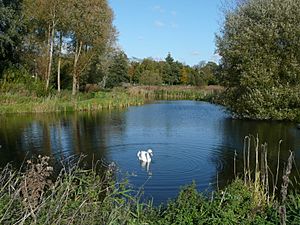Lollycocks Field facts for kids
Quick facts for kids Lollycocks Field |
|
|---|---|

Lollycocks Pond
|
|
| Type | Local Nature Reserve |
| Location | Sleaford, Lincolnshire |
| OS grid | TF 072 460 |
| Area | 2.15 hectares |
| Managed by | Leisure Connection/rangers from Hill Holt Wood |
Lollycocks Field is a special place in Sleaford, a market town in Lincolnshire. It's a 2.15-hectare (that's about five acres!) Local Nature Reserve. This means it's a protected area where nature can thrive. It's owned by the North Kesteven District Council. The park is looked after by Leisure Connection and rangers from Hill Holt Wood.
Lollycocks Field is a wonderful spot for plants and animals. It has lots of wildflowers and wet areas, which are perfect homes for different kinds of wildlife. The pond in the field is especially popular with many creatures. You can find Lollycocks Field near the River Slea and just east of Cogglesford Mill. It's easy to visit, with public access from Eastgate. There are also car parks nearby if you're coming by car.
Contents
What is a Local Nature Reserve?
A Local Nature Reserve, or LNR, is a place set aside for nature. These areas are important for several reasons. They protect wildlife and their homes, like the wildflowers and wetlands at Lollycocks Field. LNRs also give people a chance to enjoy nature. They are great places for learning about local plants and animals. Many LNRs, including Lollycocks Field, are managed to keep them healthy. This helps ensure that nature can continue to thrive there for many years.
Exploring Lollycocks Field
Lollycocks Field is a great place to visit if you love nature. It's known for its beautiful wildflowers. These flowers attract many different insects, like butterflies and bees. The wet areas and the pond are home to other creatures. You might spot frogs, dragonflies, or even some water birds. Taking a quiet walk through the field lets you observe nature up close. It's a peaceful escape right in the town of Sleaford.
Wildlife You Might See
The pond at Lollycocks Field is a busy place! It attracts a variety of wildlife. You might see different types of ducks swimming on the water. Look closely, and you could spot tiny insects buzzing around the water's edge. Frogs and newts often live in the pond and wet areas. On land, the wildflowers provide food and shelter for many insects. Keep an eye out for colorful butterflies fluttering by. You might also see small birds looking for food in the trees and bushes.
The Importance of Habitats
Lollycocks Field has two main types of habitats: wildflower meadows and wetlands. A habitat is like a home for plants and animals. Wildflower meadows are open areas with many different flowering plants. These plants provide nectar for insects and seeds for birds. Wetlands are areas where the ground is wet, like around a pond. They are crucial for animals that need water to survive. Protecting these habitats helps many different species of wildlife. It ensures they have a safe place to live and find food.
How to Visit Lollycocks Field
Lollycocks Field is easy to find in Sleaford. It's located near the town center. You can walk to the field from Eastgate, which is a main road. If you're driving, there are car parks nearby. The Eastgate Car Park and car parks off East Banks are good options. The field is open to the public, so you can visit and enjoy nature whenever you like. Remember to be respectful of the wildlife and plants. Always stay on paths and take your litter home with you.
Nearby Attractions
Lollycocks Field is close to other interesting places in Sleaford. Just to the west, you'll find Cogglesford Mill. This is a historic watermill that is still working today. It's a great place to learn about local history. The River Slea also runs along the south side of Lollycocks Field. The river is an important part of the local environment. It adds to the natural beauty of the area. Visiting these spots together makes for a fun day out.

